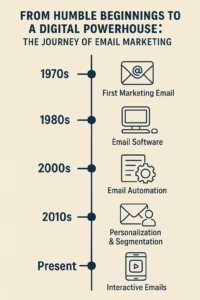Email marketing has emerged as one of the most effective digital marketing strategies since its inception in the early days of the internet. The concept of sending promotional messages via email can be traced back to the 1970s, but it wasn’t until the 1990s that businesses began to recognize its potential as a marketing tool. With the advent of user-friendly email platforms and the increasing number of internet users, companies started to leverage email as a direct line of communication with their customers.
This marked the beginning of a new era in marketing, where businesses could reach their audience with unprecedented speed and efficiency. The rise of email marketing can be attributed to several factors, including its cost-effectiveness and measurable results. Unlike traditional advertising methods, which often require significant financial investment, email marketing allows businesses to reach thousands of customers at a fraction of the cost.
Additionally, the ability to track open rates, click-through rates, and conversion rates provides marketers with valuable insights into their campaigns’ performance. This data-driven approach has enabled companies to refine their strategies continually, making email marketing an indispensable tool in their overall marketing arsenal.
Key Takeaways
- Email marketing has seen a significant rise in popularity due to its cost-effectiveness and ability to reach a wide audience.
- Email marketing has evolved from simple text-based messages to highly personalized and interactive content.
- Personalization is a powerful tool in email marketing, allowing businesses to tailor their messages to individual recipients.
- Automation plays a crucial role in email marketing, allowing for targeted and timely communication with customers.
- Integrating email marketing with other channels such as social media and mobile apps can enhance the overall marketing strategy and reach a larger audience.
The Evolution of Email Marketing
As technology has advanced, so too has email marketing. Initially, email campaigns were relatively simple, consisting mainly of text-based messages sent to large lists of recipients. However, as consumer preferences evolved and technology improved, marketers began to adopt more sophisticated techniques.
The introduction of HTML emails allowed for visually appealing designs that could incorporate images, colors, and branding elements, making emails more engaging and effective at capturing attention. Furthermore, the rise of segmentation and targeting has transformed how businesses approach their email marketing efforts. Instead of sending generic messages to a broad audience, marketers can now segment their lists based on various criteria such as demographics, purchase history, and engagement levels.
This targeted approach ensures that recipients receive content that is relevant to their interests and needs, significantly increasing the likelihood of conversion. The evolution of email marketing has also seen the integration of advanced analytics tools that provide deeper insights into customer behavior, enabling marketers to optimize their campaigns for better results.
The Power of Personalization

For instance, a study by Experian found that personalized subject lines can increase open rates by 26%, highlighting the importance of customization in capturing attention. Beyond simply addressing recipients by name, personalization can extend to product recommendations based on past purchases or browsing behavior. E-commerce giants like Amazon have mastered this technique by sending targeted emails that suggest products aligned with a customer’s previous interactions on their platform.
This level of personalization not only enhances the customer experience but also drives sales by presenting relevant offers at the right time. As consumers increasingly expect tailored experiences, businesses that prioritize personalization in their email marketing efforts are likely to see improved engagement and loyalty.
The Role of Automation in Email Marketing
Automation has revolutionized email marketing by allowing businesses to send timely and relevant messages without manual intervention. Automated email campaigns can be triggered by specific actions taken by users, such as signing up for a newsletter or abandoning a shopping cart. This capability enables marketers to nurture leads and maintain engagement with customers throughout their journey.
For example, a welcome email series can be automatically sent to new subscribers, introducing them to the brand and encouraging them to explore products or services. Moreover, automation facilitates the implementation of drip campaigns, where a series of emails are sent over time to guide recipients through a sales funnel. These campaigns can be tailored based on user behavior, ensuring that recipients receive content that aligns with their interests and stage in the buying process.
By leveraging automation, businesses can maintain consistent communication with their audience while freeing up valuable time for marketers to focus on strategy and creative development.
The Integration of Email Marketing with Other Channels
In today’s multi-channel marketing landscape, integrating email marketing with other channels is essential for maximizing reach and effectiveness. Email works synergistically with social media, content marketing, and paid advertising to create a cohesive brand experience for consumers. For instance, businesses can use social media platforms to grow their email lists by promoting exclusive offers available only through email subscriptions.
This cross-channel approach not only increases subscriber numbers but also enhances brand visibility across different platforms. Additionally, integrating email marketing with content marketing can drive traffic to a company’s website or blog. By sharing valuable content through email newsletters, businesses can encourage subscribers to engage further with their brand online.
This strategy not only positions the company as an authority in its industry but also fosters a sense of community among subscribers who share similar interests. The seamless integration of various marketing channels ensures that businesses can deliver consistent messaging while reaching customers where they are most active.
The Importance of Mobile Optimization
With the proliferation of smartphones and mobile devices, optimizing email marketing for mobile users has become paramount. A significant portion of emails is now opened on mobile devices, making it crucial for marketers to ensure that their emails are mobile-friendly. This includes using responsive design techniques that allow emails to adapt to different screen sizes and ensuring that content is easily readable without excessive scrolling or zooming.
Moreover, mobile optimization extends beyond design; it also encompasses user experience elements such as load times and call-to-action buttons. Emails that load slowly or have poorly placed buttons can lead to frustration and increased bounce rates. Marketers must prioritize creating a seamless experience for mobile users by testing emails across various devices and platforms before launching campaigns.
By doing so, businesses can capture the attention of on-the-go consumers and drive higher engagement rates.
The Continued Relevance of Email Marketing in a Digital World
Despite the emergence of new digital marketing channels such as social media and instant messaging apps, email marketing remains a relevant and powerful tool for businesses. One reason for this enduring relevance is the sheer volume of users who rely on email for communication. According to Statista, there were over 4 billion email users worldwide in 2020, a number projected to grow in the coming years.
This vast audience presents an unparalleled opportunity for businesses to connect with potential customers directly. Furthermore, email marketing offers unique advantages that other channels cannot replicate. For instance, unlike social media platforms where algorithms dictate visibility, emails land directly in recipients’ inboxes, ensuring that messages are seen by those who have opted in to receive them.
Additionally, email provides a level of personalization and direct communication that is often lacking in other forms of digital marketing. As long as consumers continue to use email as a primary means of communication, businesses will find value in leveraging this channel for their marketing efforts.
The Future of Email Marketing
Looking ahead, the future of email marketing is poised for continued growth and innovation. As technology evolves, marketers will have access to more sophisticated tools and techniques for enhancing their campaigns. Artificial intelligence (AI) is expected to play a significant role in shaping the future of email marketing by enabling more advanced personalization and predictive analytics.
AI-driven algorithms can analyze vast amounts of data to identify patterns in consumer behavior, allowing marketers to tailor their messages with greater precision. Moreover, as privacy concerns grow and regulations like GDPR become more prevalent, marketers will need to adapt their strategies accordingly. Building trust with consumers will be essential for maintaining successful email marketing campaigns.
This may involve transparent data collection practices and providing clear options for subscribers regarding how their information is used. In conclusion, while the landscape of digital marketing continues to evolve rapidly, email marketing remains a cornerstone strategy for businesses seeking to engage with their audience effectively. By embracing personalization, automation, integration with other channels, mobile optimization, and adapting to changing regulations, marketers can ensure that they harness the full potential of this powerful tool in the years to come.
If you’re interested in learning more about how email marketing can benefit your business, be sure to check out the services offered by Noticestry. They specialize in helping local businesses thrive through digital marketing strategies, as discussed in their article on supporting local business. For more insights on the power of email marketing, be sure to read their blog post titled Noticestry Blog.
FAQs
What is email marketing?
Email marketing is a digital marketing strategy that involves sending promotional messages, updates, and information to a group of people via email. It is often used to build relationships with potential customers, keep current customers informed and updated on the company’s products or services, and promote special offers.
Is email marketing still effective in today’s digital landscape?
Yes, email marketing is still a highly effective marketing strategy. It continues to deliver the highest return on investment (ROI) compared to other marketing channels. According to a study by the Data & Marketing Association, for every $1 spent on email marketing, the average return is $42.
How does email marketing compare to other marketing channels in terms of ROI?
Email marketing consistently outperforms other marketing channels in terms of ROI. It has been found to deliver a higher ROI than social media marketing, search engine optimization, and display advertising.
What are the benefits of email marketing?
Some of the key benefits of email marketing include its cost-effectiveness, ability to reach a targeted audience, high conversion rates, and the ability to track and measure results. It also allows for personalized communication with customers and can help build brand loyalty.
What are some best practices for successful email marketing campaigns?
Some best practices for successful email marketing campaigns include building a quality email list, personalizing content, creating compelling subject lines, optimizing for mobile devices, and testing and analyzing campaign performance. It’s also important to comply with email marketing regulations, such as obtaining consent from recipients and providing an option to unsubscribe.












